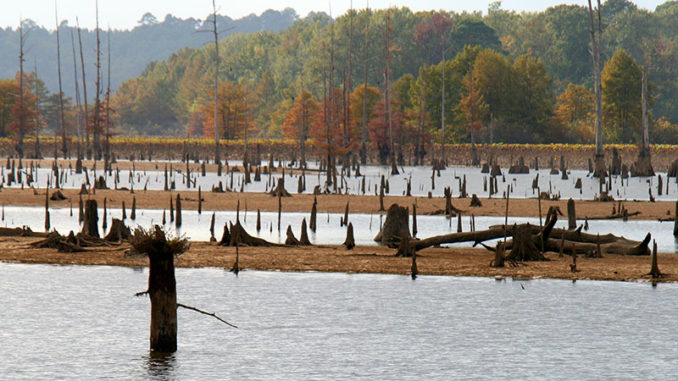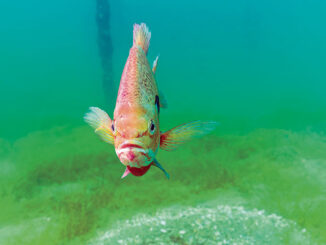
Lowering water levels to combat invasive salvinia has become a summertime ritual on a number of Louisiana lakes. Some people complain that it interferes with their fishing, but those in the know take advantage of the low water to learn more about their favorite fishing hole.
Fish tend to hang out around stumps, logs, tree tops and edges of drop-offs. While these places can be found by cruising along slowly and watching your fish finder, scouting during low water is much faster and easier. And you get the real picture.
Brandon Jennings, an avid crappie fisherman, takes advantage of drawdowns to find such structure.
“Primarily I am locating for crappie,” he said, “but all fish relate to these natural features.”
Jennings begins his scouting at home by studying Google Earth and his fishing electronics’ maps to locate areas that may have the things he’s searching for.
“I will begin looking for areas as far from the dam as I can locate,” he said. “These will be the areas most exposed at drawdown, giving you the best perspective of what is located underwater at full pool.”
Jennings likes to look for structures where the water depth changes, but he doesn’t just record large tree tops and stump lines.
“Pay special attention to small isolated features, such as that lone stump or even that one small stick-up that separates itself from other structures nearby but is still related to the contour,” he said. “Many times, larger crappie will hold off from larger groups and stage up on these small isolated structures.”
Mark it
When you find promising structure, mark it with your depth finder, smart phone or hand-held GPS. Then record it in a notebook with a detailed description and perhaps even photos that you can refer to later.
It also pays to park the boat and walk the dry lake bed to locate isolated deep holes, sloughs and humps that are not visible from the channel.
According to Jennings, “This is also a great opportunity, where it is legal, to place stake beds and other structures exactly where you want it.”
If you like to bream fish, keep an eye out for the dish plate depressions of bream beds because bream use the same bedding areas over and over. Sometimes they are not where you expect.
I grew up fishing Black Lake near Clarence and often fished for bluegills around thick cypress groves known locally as “islands.” Once, when the lake was down, I walked around those islands and was surprised to find that most of the bream beds were actually much farther away from the cypress trees than where I normally fished.
Where to stay
This summer, drawdowns are scheduled for lakes Bistineau, Bundick, Claiborne, Hardwater and Henderson. The Lake Bistineau State Park is a good place to stay when scouting its 16,000 acres.
The park has 17 premium and 44 improved campsites with water and electricity, 7 furnished cabins that sleep 8, and a lodge for up to 14 people. For large gatherings, such as family reunions, there is a group camp with a dining hall and 20 cabins that accommodates 120 people.
Guests at Bistineau can also enjoy hiking the park’s 8 miles of trails, and horse owners can take advantage of a 6-mile equestrian trail. Young and old visitors alike will enjoy playing the park’s disc golf course.
The state park’s boat ramps are closed during lake drawdowns, but boats can still be launched at Port O’ Bistineau, the Bossier Public Launch, Grice Road Landing and Bayou Dorcheat Public Launch.


